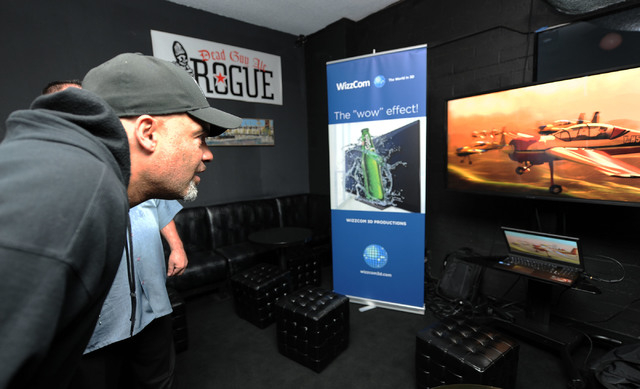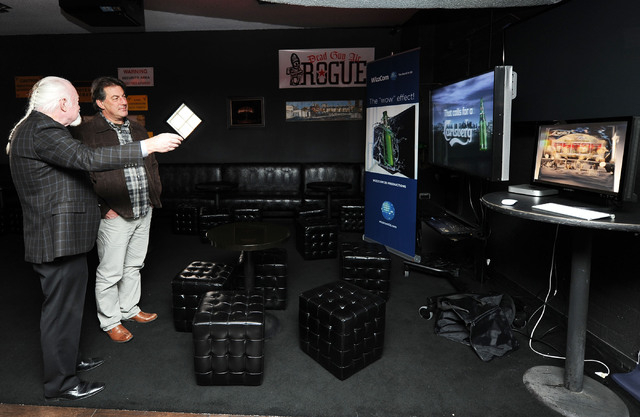Swedish company showcases glasses-free 3-D in Las Vegas




“Autostereoscopic” is a fancy way of saying glasses-free 3-D.
That’s right, three-dimensional images that don’t require the viewer to wear special lenses. Instead, a lens is bonded to a monitor to project pop-out graphics, giving the illusion of depth.
“The lens replaces the glasses,” said Mike Flynn, consultant with WizzCom 3D Inc.
At least two companies in Las Vegas are working with the new technology, which has potential in marketing, educational and medical fields.
WizzCom 3D Inc., a Sweden-based company, established its only American showroom in Las Vegas to show its five 3-D monitors, which measure 21 inches to 55 inches and cost between $3,000 and $15,000.
The company focuses on advertising applications, such as digital menu boards and mall signage.
Wednesday at Atomic Liquors, WizzCom demonstrated glasses-free 3-D videos of slot machines spitting gold coins, airplanes with wings dipping outside the screen, and a CT scan of a fetus.
“This is awesome,” bystanders exclaimed while grasping at ice-blue vodka bottles, twirling on screen.
Whereas glasses technology offers a two-camera perspective, glasses-free offers an eight-camera point of view and can be viewed from any angle.
“If you walk around, you’re going to see the 3-D no matter where you stand,” Flynn said.
Images can pop out of the screen up to 10 feet and achieve a depth of 3 feet. Viewing ranges vary between short view, 1 foot to 3 feet, or long view, 3 feet to 6 feet. A couple of models offer the choice of landscape and portrait views.
“It’s got a million little prisms in there, and that’s what helps project,” sales manager Paul Clark said. “That’s what brings out the 3-D effect.”
Packages include the monitor with lens and 3-D software, which is a large part of WizzCom’s business. Commercials are uploaded onto Mac Minis and run through the software.
“If you don’t know how to do 3-D animation or don’t have 3-D software, we do it,” Clark said. “That’s what WizzCom is, a production company.”
Pair the package with a 3-D video camera, and the content can be live-streamed to the screen.
Clients so far include Disney and San Diego State University. Locally, Clark has spoken to casinos and downtown production companies, though a sale hasn’t been completed.
The lenses are built by Alioscopy, a Paris manufacturer, and are bonded to TV monitors built by Mitsubishi, LG, NEC and Sharp.
Later this year, the company should finish a video wall that bundles four 55-inch TVs for a width of 110 inches.
Neo3Do, a 3-D tablet company, moved to Las Vegas from San Diego late last year.
The 8.1-inch Android tablet is slightly larger than an iPad mini and can stream 3-D videos from YouTube and other mobile apps. It retails for $349.
Founders David Briggs and Nick Spriggs developed the tablet specifically for classroom use.
Though glasses-free 3-D is emerging, traditional 3-D with glasses isn’t going away any time soon.
“The glasses are still good,” Clark said. “I don’t think glasses will be going out. It will probably be another five to 10 years before glasses are out.”
Home use, he said, isn’t likely until all major networks start using 3-D cameras and lens prices drop.
Flynn estimates it will be five years before people have glasses-free 3-D TVs in their homes.
“I can see it coming out in movie theaters first,” Clark said.
Contact reporter Kristy Totten at ktotten@reviewjournal.com or 702-477-3809. Follow @kristy_tea on Twitter.












